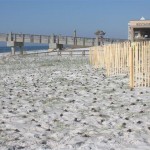Sea-oats or Seaoats or Sea Oats or Uniola paniculata or Beach Grass
Sea Oats or Uniola Paniculata are a unique, perennial grass naturally occurring from Virginia to Texas, along landward edges of coastal beaches, which consist of a mixture of moderately alkaline sand and fine shell fragments. Inland edges, upland of tidal zones, support pioneer and diversity plant species known for salt-tolerance from regular exposure to salt spray and periodic storm impacts (e.g.wave over wash). Sea Oats can reach 3-5 feet in height and commonly form extensive rhizomes, especially in unconsolidated sandy soil. Characteristics include: Sun/Salt/Heat/Low Nutrient/Drought/Flood/Wind Tolerant. Hardiness Zone 7+. Sea Oats can be identified by their showy inflorescence, a panicle, with flat, green to tan-brown spikelets, remnants of which appear year-round. A similar grass, Panic Grass or Bitter Panicum (Panicum amarum) can be differentiated from Sea Oats by silvery color, wider width of leaf blades, smaller oval spikelets, longer panicle, and found more landward (back dune). Several coastal US states have laws protecting Sea Oats from collection, harvest, damage or removal.
Beach sand renourishment projects may subsequently include a vegetation component to restore lost habitat for wildlife and sand stabilization. These projects often have planting areas and accesses that require the following services: 1) layout of the work, 2) plant material such as Sea Oats, Panic Grass, Dune Sunflower, Beach Elder, Sea Purslane, Railroad Vine, Saltgrass, Seashore paspalum, Seacoast Bluestem, Saltmeadow Cordgrass, Seashore Dropseed, Seagrape, and Saw Palmetto, 3) plant unit handling, transportation and installation, 4) hydration and fertilization, 5) warranty, success criteria and replanting, sand fence installation, and derelict or legacy sand fence, signage and/or post removal. Aquatic Plants of Florida provides these services for State, Local, and Federal projects.
For more information about Seaoats, please visit HOME PAGE www.seaoatsplantsforsale.com or http://www.fl.nrcs.usda.gov/programs/pmc/flplantmaterials.html.

